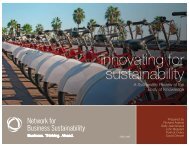embedding sustainability in organizational culture - Network for ...
embedding sustainability in organizational culture - Network for ...
embedding sustainability in organizational culture - Network for ...
You also want an ePaper? Increase the reach of your titles
YUMPU automatically turns print PDFs into web optimized ePapers that Google loves.
Chapter 1: 3: Introduction Foster<strong>in</strong>g Commitment<br />
19<br />
engage<br />
This category consists of <strong>in</strong><strong>for</strong>mal practices that attempt to raise the level of<br />
employee engagement throughout the organization. These practices aim to generate<br />
<strong>in</strong>terest and excitement among employees about the journey toward <strong>susta<strong>in</strong>ability</strong><br />
and to encourage the active participation of all employees <strong>in</strong> <strong>susta<strong>in</strong>ability</strong><br />
<strong>in</strong>itiatives. These practices help motivate employees to act <strong>in</strong> a way that br<strong>in</strong>gs<br />
the organization closer to its <strong>susta<strong>in</strong>ability</strong> goals. The practices that relate to<br />
engagement <strong>in</strong>clude educat<strong>in</strong>g; challeng<strong>in</strong>g; l<strong>in</strong>k<strong>in</strong>g; support<strong>in</strong>g; leverag<strong>in</strong>g;<br />
captur<strong>in</strong>g quick w<strong>in</strong>s; and recogniz<strong>in</strong>g.<br />
EducatE: Raise the level of awareness and understand<strong>in</strong>g of <strong>susta<strong>in</strong>ability</strong><br />
through the provision of <strong>in</strong><strong>for</strong>mation <strong>in</strong> <strong>in</strong><strong>for</strong>mal ways<br />
• Include <strong>susta<strong>in</strong>ability</strong> <strong>in</strong><strong>for</strong>mation <strong>in</strong> company newsletters,<br />
on bullet<strong>in</strong> boards, or <strong>in</strong> memos<br />
• Br<strong>in</strong>g <strong>in</strong> speakers to talk about <strong>susta<strong>in</strong>ability</strong> issues<br />
• Host <strong>in</strong>ternal workshops, conferences or trade shows<br />
Practitioners note the importance of provid<strong>in</strong>g <strong>in</strong><strong>for</strong>mation about <strong>susta<strong>in</strong>ability</strong> to<br />
<strong>in</strong>crease the awareness and understand<strong>in</strong>g of the concept among employees. While<br />
little research has explored the role of <strong>in</strong><strong>for</strong>mal education, Molnar and Mulvihill<br />
(2003) note that <strong>in</strong>vit<strong>in</strong>g <strong>in</strong> <strong>in</strong>dustry leaders to speak to employees can <strong>in</strong>spire<br />
new <strong>susta<strong>in</strong>ability</strong> <strong>in</strong>itiatives. We discuss the <strong>for</strong>mal practice of tra<strong>in</strong><strong>in</strong>g <strong>in</strong> the next<br />
chapter.<br />
assessment: proposed but not tested<br />
challEngE: Encourage and recognize good ideas or ef<strong>for</strong>t through <strong>in</strong>ternal<br />
competitions<br />
• Organize <strong>susta<strong>in</strong>ability</strong> competitions between bus<strong>in</strong>ess units or<br />
regional units to motivate <strong>susta<strong>in</strong>ability</strong> per<strong>for</strong>mance<br />
• Use <strong>in</strong>ternal competitions as a means to generate and identify new ideas<br />
Several practitioners have suggested that <strong>in</strong>ternal competitions can be used to build<br />
<strong>in</strong>terest <strong>in</strong> <strong>susta<strong>in</strong>ability</strong>, to generate new ideas and to identify and recognize good<br />
ideas. These practitioners suggest that it is important to keep a positive frame on the<br />
competitions, but when done correctly, that competition can be a good motivator<br />
(Ethical Corporation, 2009; NBS, 2010).<br />
In one example, described by Goodman (2000), bus<strong>in</strong>ess units were awarded<br />
additional tra<strong>in</strong><strong>in</strong>g resources <strong>for</strong> energy, water and waste reductions. This <strong>in</strong>itiative<br />
resulted <strong>in</strong> significant reductions across the company.<br />
More research is needed to explore further the role of competition <strong>in</strong> <strong>embedd<strong>in</strong>g</strong><br />
<strong>susta<strong>in</strong>ability</strong>.<br />
assessment: Weakly supported<br />
l<strong>in</strong>k: Br<strong>in</strong>g <strong>susta<strong>in</strong>ability</strong> down to the <strong>in</strong>dividual level by connect<strong>in</strong>g the<br />
impact of everyday actions at work with <strong>susta<strong>in</strong>ability</strong> at home (and<br />
vice versa); connect <strong>organizational</strong> <strong>susta<strong>in</strong>ability</strong> activities to personal<br />
<strong>susta<strong>in</strong>ability</strong> activities (and vice versa)<br />
• Encourage employees to br<strong>in</strong>g their personal <strong>susta<strong>in</strong>ability</strong><br />
behaviours <strong>in</strong>to the workplace<br />
• Encourage employees to carry the <strong>organizational</strong> <strong>susta<strong>in</strong>ability</strong><br />
message <strong>in</strong>to their communities<br />
Br<strong>in</strong>g<strong>in</strong>g <strong>susta<strong>in</strong>ability</strong> down to the level of <strong>in</strong>dividual actions appears to make it<br />
more concrete. Further, l<strong>in</strong>k<strong>in</strong>g employee actions at work to their behaviours at<br />
home and <strong>in</strong> their communities appears to re<strong>in</strong><strong>for</strong>ce these behaviours. One senior<br />
manager recommended encourag<strong>in</strong>g staff to br<strong>in</strong>g their personal <strong>susta<strong>in</strong>ability</strong><br />
behaviours <strong>in</strong>to the workplace (Ethical Corporation, 2009). A practitioner <strong>in</strong><br />
Goodman’s (2000) study suggested that messages about <strong>susta<strong>in</strong>ability</strong> are attractive<br />
when employees can also use the knowledge <strong>in</strong> their private lives. Hart (2005)<br />
encourages organizations to allow employees to align their values with their job.<br />
Research by Bansal (2003) <strong>in</strong> the area of <strong>susta<strong>in</strong>ability</strong> beg<strong>in</strong>s to provide support <strong>for</strong><br />
this idea. Her research demonstrates reciprocal l<strong>in</strong>ks between <strong>organizational</strong> and<br />
<strong>in</strong>dividual actions.<br />
In the quality literature, Blackburn and Rosen (1993) describe how leaders <strong>in</strong> quality<br />
improvement re<strong>in</strong><strong>for</strong>ce a ‘prevention-oriented approach’ by provid<strong>in</strong>g personal<br />
health and safety services to employees. Not only do these practices emphasize<br />
the organizations’ proactive approach to problems, but they create a positive and<br />
satisfy<strong>in</strong>g environment <strong>for</strong> employees.<br />
L<strong>in</strong>k<strong>in</strong>g is a practice that has received prelim<strong>in</strong>ary support <strong>in</strong> the literature, but still<br />
requires more study.<br />
assessment: Weakly supported
















